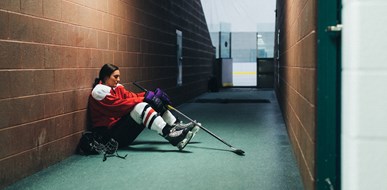Addressing human rights abuse in sport
Published 15 December 2022By Jasper Schellekens

@iStock
The sports industry has recently been faced with increasing reports of abuse and is struggling to respond to these cases of human rights abuse. This has led to re-traumatisation and further harm to affected athletes. What are the main challenges faced by sports to address human rights abuse safely and effectively?
Recent years have demonstrated an increasing need to effectively deal with abuse. The #MeToo movement has sparked a broader conversation about coercive and abuse behaviour that has spread from industry to industry. The sport industry has been no exception, with the International Olympic Committee stating that prevalence of abuse (and sexual harassment) is even higher at the elite level of sport.
Cases of abuse in sport crosscut all level and disciplines, and abuse reports have increased in recent years across the globe. In March 2022, the Guardian published a list of sexual abuse cases and allegations made in football in the past few years. Confined to the space of a few years and only to the sport of football, as the journalists point out, this is only the tip of the iceberg.
Other examples are abuse allegations in Dutch gymnastics and US gymnastics, abuse of female basketball players in Mali, systematic abuse of child athletes in Japan, abuse of young boys within English football, or sexual abuse of the Afghanistan National Women’s Football Team.
Abuse goes unreported
While there has been a notable increase in reports of abuse, a sweeping 93% of individuals who experienced sexual harassment or unwanted sexual contact did not formally report it, according to a 2021 report by the US Centre for safe sport. Another study conducted jointly by the United Nations Office on Drugs and Crime and the International Olympic Committee reinforces that abuse in sport is still underreported, despite the shift in awareness and an increase of reporting mechanisms.
When we look at the main challenges faced by the sports industry to address human rights abuse, four key themes stand out: a lack of resources, power imbalances, an incorrect handling of whistle-blowers and victims, and the lack of a safe and systematic approach to address abuse in sport.
Resources are not available for athletes
The majority of athletes are not super-stars. In fact, a report by FIFPRO - one of the partners in our upcoming masterclass on human rights abuse in sport – shows that many football players struggle to make ends meet. Globally, nearly half of the professional players are earning less than a thousand dollars a month. Athletes struggling financially and sports organisations lacking the capacity to detect and investigate reports of abuse lead to severe gaps in addressing human rights abuse in sport. The resources are often simply not available.
Power imbalances
Another important challenge in addressing human rights abuses are the power imbalances between perpetrator, affected person, and those in charge of addressing it. In sport, this power imbalance is particularly pronounced due to a prevalent ‘culture of obedience and deference to authority.’
Perpetrators often use their position of authority and their power to influence athletes. Examples include Michigan State University and USA Gymnastics doctor Larry Nassar, who was convicted for sexual abuse of more than three hundred girls and women, often under the guise of pain treatment.
In 2021, an independent report on New Zealand Gymnastics also found that complaints of psychological and physical abuse were not made as the victims feared retaliation or feared the process as being damaging to the wellbeing of the child.
This power imbalance is one of the key challenges to address when conducting an investigation. Therefore, even when organisations do investigate (which is not always the case) affected people face significant risks of additional harm and re-traumatisation if it is not done in a safe and effective way.
No systemic approach for safe investigation of abuse
Sports organisations usually set up their own organisational structures and practices to address abuse. However, as many fear the devastating reputational, staffing and financial consequences of abuse cases, sport bodies can easily try to seek to control and even cover them up.
Safety of whistle-blowers
Handling the safety of whistle-blowers and victims is challenging as well. Organisational structures and practices tend to protect abusers and perpetuate abuse rather than offer much-needed protection to victims and whistle-blowers. They are in a precarious situation, as they have just experienced harm, risk retaliation and long-lasting damage to their careers. But protecting them from further harm requires specialised knowledge.
When investigating the allegations against the Argentinian women’s football coach Diego Alberto Gaucci, Fifa’s ethics committee, for instance, published its decision before the players or representatives had been provided a copy. As FIFPRO indicated in its report, this is ‘critical in any procedure which involves victims and whistle-blowers’.
In another case, involving the US snowboarding team, the reporting process in place was convoluted and contradictory and caused the athlete to question their decision to report it at all. This summer, a group of ninety women filed a lawsuit against the FBI, for its handling of the Larry Nassar case. The women claim that the agency mishandled its investigation of Nassar, and allowed him to continue to abuse them, even after they had reported Nassar to the federal agency in 2015. They are seeking more than $1 billion US dollars in compensation.
Not all of these challenges can be overcome by law or by rules and regulations, but a safe and principle-based approach can have a significant impact on mitigating the risks of additional harm to those affected during the investigation process. Too often affected people have suffered additional harm due to the manner in which the investigation was conducted. Harm that was unnecessary and could have been prevented.
[Advanced professional training] Safe, effective and appropriate investigation of human rights abuse
Together with victims and whistle-blowers, the Centre for Sports and Human Rights (CSHR) has conducted research for a good practice guide that can help prevent further harm to affected parties. CSHR is partnering with the Asser Institute to offer a professional training, based on findings from that research. The training is led by Daniela Heerdt and award-winning human rights lawyer, Kat Craig, and based on the good practice guide that CSHR has developed. Register now and get the tools needed to start making sports safer.
Read more
Remedy and redress for sport-related human rights abuses by Daniela Heerdt and William Rook in the International Sports Law Journal (2022).
Centre for Sports and Human Rights: An overview of athlete abuse

